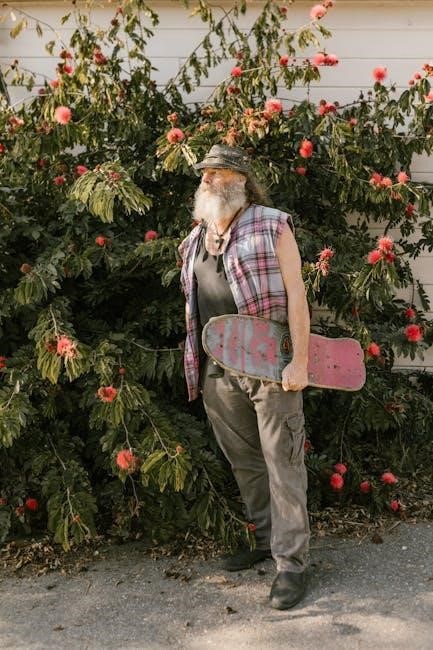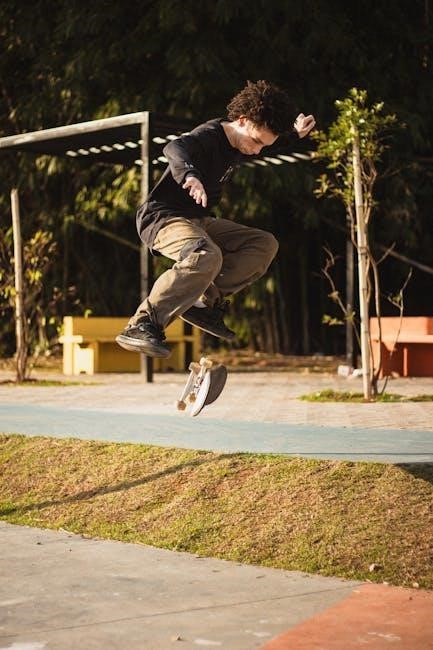
What Are Skateboard Bushings?
Skateboard bushings are rubber cushions fitted around the kingpin in trucks, enabling smooth turning and stability․ Made from polyurethane, they absorb shocks and provide customized ride feel․
The Role of Bushings in Skateboard Performance
Skateboard bushings play a crucial role in determining the overall performance of a skateboard․ They are responsible for enabling smooth turning and providing stability by absorbing shocks and vibrations during rides․ Bushings act as cushions between the truck’s hanger and baseplate, allowing the truck to pivot smoothly around the kingpin․ Their flexibility and responsiveness directly impact how a skateboard handles, making them essential for both casual cruising and advanced maneuvers․ By customizing bushings, riders can tailor the board’s turning sensitivity and stiffness to suit their skating style, weight, and personal preference․ Properly functioning bushings ensure better control, smoother rides, and enhanced durability of the skateboard setup․
Materials Used in Skateboard Bushings
Skateboard bushings are primarily made from polyurethane, a durable and flexible material that provides excellent shock absorption and resistance to wear․ This synthetic rubber is favored for its ability to maintain shape under pressure while offering the right amount of rebound for smooth turning․ The hardness of polyurethane bushings is measured using a durometer scale, which determines their stiffness and responsiveness․ Softer bushings (lower durometer ratings) offer more flex for easier turning, while harder bushings (higher ratings) provide stability and resistance to compression․ Some bushings may include additives like oils or plastics to enhance performance, such as improving rebound or heat resistance, ensuring a customized ride for different skating styles and preferences․

Types of Bushings
Skateboard bushings come in two main types: tapered (cone) and straight (barrel)․ Tapered bushings allow for precise turning, while straight bushings offer consistent support and stability for various riding styles․
Tapered (Cone) Bushings
Tapered bushings, also known as cone bushings, are shaped like a cone, with one end narrower than the other․ This design allows for more precise turning and maneuverability, making them ideal for carving and cruising․ The narrower end of the bushing provides responsiveness, while the wider end offers stability, creating a balanced ride․ Tapered bushings are popular among skateboarders who prioritize agility and control․ They are often preferred by those who enjoy technical skating or need quick, sharp turns․ The tapered shape enables the trucks to lean more effectively, enhancing the overall performance of the board․
Straight (Barrel) Bushings
Straight or barrel bushings are cylindrical in shape, offering a consistent and uniform response․ Unlike tapered bushings, they do not narrow at either end, providing a predictable and stable ride․ This design makes them suitable for downhill skating, where stability and control at high speeds are crucial․ Barrel bushings are favored by riders who need a solid, unchanging feel during turns․ They are often paired with softer durometer ratings to maintain flexibility while ensuring durability․ The straight shape distributes pressure evenly, making them a reliable choice for skaters prioritizing stability and consistency in their riding style․

Durometer Ratings
Durometer ratings measure the hardness of skateboard bushings, ranging from 70A to 100A․ Higher ratings indicate harder bushings for stability, while lower ratings offer flexibility and cushioning․
Understanding Hardness Levels
Durometer ratings, measured on the Shore A scale, determine the hardness of skateboard bushings․ Ratings typically range from 70A (softer) to 100A (harder)․ Softer bushings (70A-85A) provide more cushioning and flexibility, ideal for carving and cruising, while harder bushings (90A-100A) offer stability and responsiveness, better for high-speed skating or heavier riders․ The hardness level directly impacts how the board turns and reacts to weight shifts․ Riders often choose bushings based on their weight, skating style, and personal preference for comfort or control․ Understanding these hardness levels helps skaters customize their setup for optimal performance and ride quality․
Choosing the Right Durometer for Your Ride
Selecting the right durometer for your skateboard bushings depends on your weight, skating style, and personal preference․ Lighter riders or those who prioritize comfort often opt for softer bushings (70A-85A), which allow for easier turning and better cushioning․ Heavier riders or those seeking stability, especially at higher speeds, may prefer harder bushings (90A-100A)․ Street skaters often choose harder bushings for better pop and responsiveness, while cruisers and carvers lean toward softer options for smoother transitions․ Experimenting with different durometers can help you find the perfect balance between control and comfort, ensuring your setup matches your riding style and performance needs․

Bushing Configuration
Bushing configuration involves the setup and adjustment of bushings on your skateboard trucks, ensuring proper tightness for optimal turning and stability, while maintaining overall ride performance․
Setup and Installation Tips
Properly setting up and installing skateboard bushings is crucial for optimal performance․ Start by assessing your ride style and weight to select the right hardness․ Tightening the kingpin nut is not the best way to achieve tighter trucks; instead, focus on swapping out bushings for major adjustments․ Use a wrench to tighten the nut just enough to hold the bushings in place without overcompressing them․ Ensure the bushings are seated correctly and aligned with the truck’s baseplate․ Experiment with different configurations to find the perfect balance of responsiveness and stability․ Regularly check and tighten the kingpin nut to maintain your setup and prevent wear․ Clean and lubricate the kingpin periodically for smooth operation․
How to Tighten and Maintain Bushings
Tightening and maintaining skateboard bushings ensures optimal performance and extends their lifespan․ Use a wrench to tighten the kingpin nut gradually, avoiding overtightening, which can restrict movement․ Check the tightness after each session and adjust as needed․ Clean the bushings and kingpin regularly by removing dirt and grime with a cloth or brush․ Lubricate the kingpin with a skate-specific lubricant to reduce friction and wear․ Replace worn or misshapen bushings promptly to maintain stability and control․ Avoid exposing bushings to harsh chemicals or extreme temperatures, as this can degrade the material․ Regular maintenance keeps your trucks responsive and ensures a smooth, consistent ride․

Selecting the Best Bushings
Choose bushings based on your weight, skating style, and personal preference․ Consider hardness, shape, and material to optimize performance and comfort for your unique riding needs․
Factors to Consider (Weight, Style, Preference)
Your weight plays a significant role in choosing the right bushings, as heavier riders may need stiffer options for stability․ Skating style is equally important—street skaters might prefer softer bushings for easier turning, while downhill riders require harder ones for precision; Personal preference also matters, as some riders prioritize comfort and flexibility, while others focus on responsiveness․ Considering these factors ensures you select bushings that align with your riding needs and enhance your overall performance․ Experimenting with different setups can help you find the perfect balance for your unique skating experience․
Top Brands and Their Popular Models
Prominent brands like Independent, Bones, and Riptide are well-known for their high-quality bushings․ Independent offers the #3 Hard Bushings, a favorite among skaters seeking durability․ Bones Hardcore Soft Bushings are praised for their excellent cushioning and responsiveness․ Riptide’s WFB and Kegel bushings are popular for their versatility, catering to various skating styles․ Carver’s C7 and CX models are also highly regarded, providing precise control and a smooth ride․ These brands consistently deliver reliable performance, making them top choices for skaters worldwide․ Exploring these options helps riders find the perfect fit for their unique preferences and skating demands․

Troubleshooting Common Issues
Common issues include excessive wear, misalignment, and improper hardness; Replacing worn bushings with the right durometer and ensuring proper installation can resolve these problems effectively․

Diagnosing and Fixing Bushing Problems
Identify issues like excessive wear, uneven compression, or misalignment․ If bushings are too hard, turning may feel stiff; if too soft, stability suffers․ Inspect for cracks or deformation․ Replace worn or damaged bushings promptly to maintain performance․ Ensure proper installation by aligning the kingpin correctly and tightening the nut evenly․ For misaligned trucks, adjust the bushings or kingpin․ Regularly clean and lubricate components to prevent friction buildup․ Test ride after adjustments to confirm improvements․ Addressing these issues early prevents further damage and enhances overall skating experience․